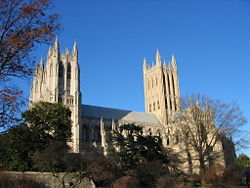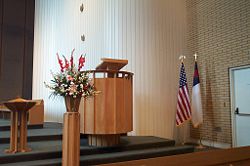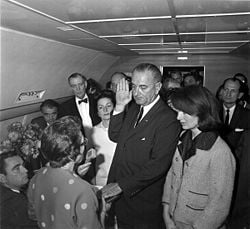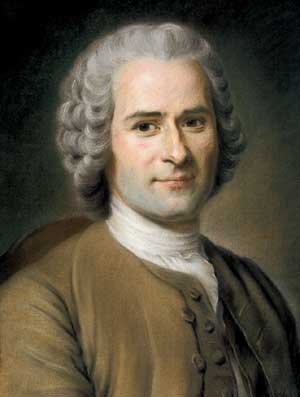Difference between revisions of "Civil Religion" - New World Encyclopedia
Rosie Tanabe (talk | contribs) |
|||
| (14 intermediate revisions by 7 users not shown) | |||
| Line 1: | Line 1: | ||
| − | {{ | + | {{Images OK}}{{submitted}}{{approved}}{{Paid}}{{Copyedited}} |
| + | [[Image:LBJ taking the oath of office.jpg|thumb|250px|Former U.S. President Lyndon Baines Johnson takes the oath of his office with his left hand on a Bible.]] | ||
| + | '''Civil religion''' is the [[folk religion]] of a [[nation]], often involving ritual expressions of [[patriotism]]. It is frequently given merit by [[leadership|leader]]s within a society, for example with the invocation of [[God]] in political speeches or religious references relating to [[National Day|patriotic holidays]]. | ||
| + | |||
| + | In 1763, [[Jean-Jacques Rousseau]] coined the term "civil religion" in his ''[[The Social Contract]],'' to describe what he regarded as the moral and spiritual foundation essential for any modern society. In the 1950s and 1960s, scholars studied civil religion as a cultural phenomenon, attempting to identify the actual tenets of civil religion in the [[United States of America]], or to study civil religion as a phenomenon of [[cultural anthropology]]. | ||
| + | |||
| + | As a defining factor in civil religion, the term "[[Judeo-Christian]] tradition" refers to the several types of [[monotheism]] practiced in the [[United States]] and Europe, based on the assumption that these faiths all worship the same God and shared similar values. | ||
| − | |||
==Origin of term== | ==Origin of term== | ||
| − | [[Jean-Jacques Rousseau]] coined the term in chapter 8, book 4 of [[The Social Contract]], to describe what he regarded as the moral and spiritual foundation essential for any modern society. | + | [[Image:Jean-Jacques Rousseau (painted portrait).jpg|thumb|Jean-Jacques Rousseau]] |
| + | [[Jean-Jacques Rousseau]] coined the term ''civil religion'' in chapter 8, book 4 of ''[[The Social Contract]],'' to describe what he regarded as the moral and spiritual foundation essential for any modern society. For Rousseau, civil religion was intended simply as a form of social cement, helping to unify the state by providing it with sacred authority. In his book, [[Rousseau]] outlines the simple dogmas of the civil religion: | ||
| + | |||
| + | <blockquote>There is therefore a purely civil profession of faith of which the Sovereign should fix the articles, not exactly as religious dogmas, but as social sentiments without which a man cannot be a good citizen or a faithful subject...The dogmas of civil religion ought to be few, simple, and exactly worded, without explanation or commentary. The existence of a mighty, intelligent and beneficent Divinity, possessed of foresight and providence, the life to come, the happiness of the just, the punishment of the wicked, the sanctity of the social contract and the laws: these are its positive dogmas.</blockquote> | ||
| − | + | Beyond that, Rousseau affirmed that individuals' religious opinions should be beyond the reach of governments. However, he believed that the punishment for violating the dogmas of civil religion for one who has affirmed his commitment to them ought to be death because: "he has committed the worst of all crimes, that of lying before the law." | |
| − | |||
| − | |||
| − | + | As the term is used today, civil religion is not a formal or official creed. Indeed, the dogmas of a particular society's civil religion are often hard to define or even recognize. | |
| − | ===Examples | + | ==Contemporary civil religion== |
| + | [[Image:National Cathedral.jpg|thumb|250px|The [[Washington National Cathedral]] in [[Washington, D.C.]] is often used for state [[funeral]]s for political leaders.]] | ||
| + | In the [[sociology of religion]], "civil religion" is the [[folk religion]] of a [[nation]] or a [[politics|political]] [[culture]]. However, it stands somewhat above mere folk religion in its social and political status. It is often practiced somewhat formally by [[leadership|leader]]s of the society, who can be seen as acting as its priests. For example, the U.S. president often ends his speeches by intoning the words, "May God bless America." On the other hand, civil religion is nowhere a formally established religion, as Rousseau intended. Examples include: | ||
| − | |||
*the invocation of [[God]] in political speeches and public [[monument]]s; | *the invocation of [[God]] in political speeches and public [[monument]]s; | ||
*the quotation of [[religious text]]s on public occasions by political leaders; | *the quotation of [[religious text]]s on public occasions by political leaders; | ||
| Line 25: | Line 32: | ||
and similar religious or quasi-religious practices. | and similar religious or quasi-religious practices. | ||
| − | + | Nations committed to the [[separation of church and state]] tend to be less specific in their civil religion traditions than nations with state churches. Thus, the term "civil religion" or "civic religion" can also refer to [[ritual]] expressions of [[patriotism]] of a sort practiced in all countries, not always including religion in the conventional sense of the word. Among such practices are : | |
| − | |||
| − | |||
| − | Among such practices are | ||
| − | |||
*crowds singing the national anthem at certain public gatherings; | *crowds singing the national anthem at certain public gatherings; | ||
| − | *parades or | + | *parades or displays of the national flag on certain [[National Day|patriotic holidays]]; |
| − | *[[oath of allegiance|oaths of allegiance]] | + | *[[oath of allegiance|oaths of allegiance]]; |
| − | *ceremonies | + | *ceremonies relating to the inauguration of a president or the coronation of a king; |
| − | *retelling exaggerated, one-sided, and simplified [[mythology|mythologized]] tales of [[Founding Fathers]] and other great leaders or great events (e.g., battles, mass migrations) in the past (in this connection, see also [[romantic nationalism]]); | + | *retelling exaggerated, one-sided, and simplified [[mythology|mythologized]] tales of the [[Founding Fathers]] and other great leaders or great events (e.g., battles, mass migrations) in the past (in this connection, see also [[romantic nationalism]]); |
*[[monument]]s commemorating great leaders of the past or historic events; | *[[monument]]s commemorating great leaders of the past or historic events; | ||
*monuments to dead soldiers or annual ceremonies to remember them; | *monuments to dead soldiers or annual ceremonies to remember them; | ||
| Line 41: | Line 44: | ||
*public display of the coffin of a recently deceased political leader. | *public display of the coffin of a recently deceased political leader. | ||
| − | == | + | Thus, even officially [[atheism|atheistic]] governments such as those of [[Cuba]], [[North Korea]], or the former [[Soviet Union]] may be said to practice an atheistic form of civil religion, with saints and mythologies of a Marxist ideological character. |
| + | |||
| + | ==American civil religion== | ||
| + | [[Image:PatriotismUSAMagnet.png|thumb|200px|left|[[Magnets]] on [[automobiles]] became a popular way to display patriotism in the United States during the 2004 elections.]] | ||
| + | |||
| + | "American civil religion" is a term coined by sociologist [[Robert Bellah]] in 1967. It sparked one of the most controversial debates in [[United States]] sociology, resulting in American civil religion being studied relatively thoroughly. | ||
| − | + | The [[United States]] was settled in part by religious [[dissenter]]s from the established [[Church of England]], who desired a civil society founded on a different religious vision. Consequently, there has never been a state church in the United States and individual state churches have not existed in the United States since the early nineteenth century. Religious denominations compete with one another for allegiance in the public square. These facts have made public displays of religious piety by political leaders important to a large sector of the population; lacking an established church, they need public assurance of those leaders' religious beliefs. | |
| − | + | Bellah argued that America has experienced three periods of crisis when a large number of Americans were cynical about the American creed. When "the spiritual glue that had bound the nation together in previous years had simply collapsed." The [[History of the United States (1776-1789)|founding of the nation]] is the first period, since it was by no means clear that the American people could actualize the American creed. The [[American Civil War|Civil War]] and the [[Counterculture of the 1960s|1960s]] were the other two periods. | |
| − | |||
| − | |||
| − | + | Bellah and fellow scholar [[Martin E. Marty]] studied civil religion as a cultural phenomenon, attempting to identify the actual tenets of civil religion in the [[United States of America]], or to study civil religion as a phenomenon of [[cultural anthropology]]. Marty wrote that Americans approved of "religion in general" without being particularly concerned about the content of that faith, and attempted to distinguish "[[priest]]ly" and "[[prophet]]ic" roles within the practice of American civil religion, which he preferred to call the ''public theology''. Bellah wrote that civil religion was "an institutionalized collection of sacred beliefs about the American nation." He identified the [[American Revolution]], the [[American Civil War|Civil War]], and the [[American Civil Rights Movement|Civil Rights Movement]] as three decisive historical events that impacted the content and imagery of civil religion in the United States. He also identified several modalities within U.S. civil religion related to the biblical categories of the priesthood, prophets, and wisdom tradition. | |
| − | + | [[Image:ChristianFlagEtc CovenantPresbyterianLongBeach20050213 CopyrightKaihsuTai.jpg|thumb|250px|The [[Christian flag]] displayed alongside the flag of the [[United States|USA]] next to the pulpit in a church in California. Note the eagle and cross finials on the flag poles.]] | |
| − | + | Civil religion can be problematic from a [[theology|theological]] perspective. Being identified with a political culture and a leadership [[hierarchy]] of an existing society, civil religion can interfere with the prophetic mission of a religious faith. It is hard to make civil religion a platform for rebuking the [[sin]]s of a people or its institutions, because civil religion exists to make them seem [[sacred]] in themselves. An exception to this can be seen, however, when a leader such as [[Martin Luther King, Jr.]] effectively invoked American civil religion against the sin of racism. "I have a dream," he famously said, "that one day this nation will rise up and live out the true meaning of its creed: 'We hold these truths to be self-evident, that all men are created equal.'" Earlier, [[Abraham Lincoln]] likewise had invoked the Declaration of Independence's same famous phrase in his [[Gettysburg Address]] during the [[American Civil War]]. | |
| − | |||
| − | |||
| − | The [[United States | + | The assertive form of civil religion in [[America]] is an occasional cause of political friction between the United States and its allies in [[Europe]], where civil religion is often relatively muted. In the United States, civil religion is often invoked under the name of "[[Judeo-Christian]] tradition," a phrase originally intended to be maximally inclusive of the several [[monotheism]]s practiced in the United States, assuming that these faiths all [[worship]] the same God and share the same values. This assumption tends to dilute the essence of both [[Judaism]] and [[Christianity]]; recognition of this fact, and the increasing religious diversity of the United States, make this phrase less heard now than it once was, though it is far from extinct. |
| − | + | ====Quotes==== | |
| + | *"The greatest part of...America was peopled by men who...brought with them into the New World a form of Christianity...by styling it a democratic and republican religion."—[[Alexis de Tocqueville]]. | ||
| − | + | *"While some have argued that Christianity is the national faith...few have realized that there actually exists alongside...the churches an elaborate and well-institutionalized civil religion in America."—[[Robert Bellah]] | |
| − | |||
==References== | ==References== | ||
| + | * Bellah, Robert N. ''The Broken Covenant: American Civil Religion in Time of Trial''. University of Chicago Press, 1992. ISBN 9780226041995 | ||
| + | * Bellah, Robert N. ''Varieties of Civil Religion''. San Francisco: Harper, 1982. ISBN 9780060607692 | ||
| + | * Kessler, Sanford. ''Tocqueville's Civil Religion: American Christianity and the Prospects for Freedom''. State University of New York Press, 1994. ISBN 9780791419304 | ||
| + | * Marty, Martin E. ''Civil Religion, Church and State. (Modern American Protestantism and its world, 3)''. Munich: K.G. Saur, 1991. ISBN 9780887366482 | ||
| + | * Shanks, Andrew, and Alta Bridges. ''Civil Society, Civil Religion'', Blackwell Publishing Limited, 1995. ISBN 9780631197584 | ||
[[Category:philosophy and religion]] | [[Category:philosophy and religion]] | ||
{{Credit|146115697}} | {{Credit|146115697}} | ||
Latest revision as of 18:45, 3 March 2020
Civil religion is the folk religion of a nation, often involving ritual expressions of patriotism. It is frequently given merit by leaders within a society, for example with the invocation of God in political speeches or religious references relating to patriotic holidays.
In 1763, Jean-Jacques Rousseau coined the term "civil religion" in his The Social Contract, to describe what he regarded as the moral and spiritual foundation essential for any modern society. In the 1950s and 1960s, scholars studied civil religion as a cultural phenomenon, attempting to identify the actual tenets of civil religion in the United States of America, or to study civil religion as a phenomenon of cultural anthropology.
As a defining factor in civil religion, the term "Judeo-Christian tradition" refers to the several types of monotheism practiced in the United States and Europe, based on the assumption that these faiths all worship the same God and shared similar values.
Origin of term
Jean-Jacques Rousseau coined the term civil religion in chapter 8, book 4 of The Social Contract, to describe what he regarded as the moral and spiritual foundation essential for any modern society. For Rousseau, civil religion was intended simply as a form of social cement, helping to unify the state by providing it with sacred authority. In his book, Rousseau outlines the simple dogmas of the civil religion:
There is therefore a purely civil profession of faith of which the Sovereign should fix the articles, not exactly as religious dogmas, but as social sentiments without which a man cannot be a good citizen or a faithful subject...The dogmas of civil religion ought to be few, simple, and exactly worded, without explanation or commentary. The existence of a mighty, intelligent and beneficent Divinity, possessed of foresight and providence, the life to come, the happiness of the just, the punishment of the wicked, the sanctity of the social contract and the laws: these are its positive dogmas.
Beyond that, Rousseau affirmed that individuals' religious opinions should be beyond the reach of governments. However, he believed that the punishment for violating the dogmas of civil religion for one who has affirmed his commitment to them ought to be death because: "he has committed the worst of all crimes, that of lying before the law."
As the term is used today, civil religion is not a formal or official creed. Indeed, the dogmas of a particular society's civil religion are often hard to define or even recognize.
Contemporary civil religion

In the sociology of religion, "civil religion" is the folk religion of a nation or a political culture. However, it stands somewhat above mere folk religion in its social and political status. It is often practiced somewhat formally by leaders of the society, who can be seen as acting as its priests. For example, the U.S. president often ends his speeches by intoning the words, "May God bless America." On the other hand, civil religion is nowhere a formally established religion, as Rousseau intended. Examples include:
- the invocation of God in political speeches and public monuments;
- the quotation of religious texts on public occasions by political leaders;
- the veneration of past political leaders;
- the use of the lives of these leaders to teach moral ideals;
- the veneration of veterans and casualties of a nation's wars;
- religious gatherings called by political leaders;
- the use of religious symbols on public buildings;
- the use of public buildings for worship;
- founding myths and other national myths
and similar religious or quasi-religious practices.
Nations committed to the separation of church and state tend to be less specific in their civil religion traditions than nations with state churches. Thus, the term "civil religion" or "civic religion" can also refer to ritual expressions of patriotism of a sort practiced in all countries, not always including religion in the conventional sense of the word. Among such practices are :
- crowds singing the national anthem at certain public gatherings;
- parades or displays of the national flag on certain patriotic holidays;
- oaths of allegiance;
- ceremonies relating to the inauguration of a president or the coronation of a king;
- retelling exaggerated, one-sided, and simplified mythologized tales of the Founding Fathers and other great leaders or great events (e.g., battles, mass migrations) in the past (in this connection, see also romantic nationalism);
- monuments commemorating great leaders of the past or historic events;
- monuments to dead soldiers or annual ceremonies to remember them;
- expressions of reverence for the country or the Constitution or the King;
- public display of the coffin of a recently deceased political leader.
Thus, even officially atheistic governments such as those of Cuba, North Korea, or the former Soviet Union may be said to practice an atheistic form of civil religion, with saints and mythologies of a Marxist ideological character.
American civil religion
"American civil religion" is a term coined by sociologist Robert Bellah in 1967. It sparked one of the most controversial debates in United States sociology, resulting in American civil religion being studied relatively thoroughly.
The United States was settled in part by religious dissenters from the established Church of England, who desired a civil society founded on a different religious vision. Consequently, there has never been a state church in the United States and individual state churches have not existed in the United States since the early nineteenth century. Religious denominations compete with one another for allegiance in the public square. These facts have made public displays of religious piety by political leaders important to a large sector of the population; lacking an established church, they need public assurance of those leaders' religious beliefs.
Bellah argued that America has experienced three periods of crisis when a large number of Americans were cynical about the American creed. When "the spiritual glue that had bound the nation together in previous years had simply collapsed." The founding of the nation is the first period, since it was by no means clear that the American people could actualize the American creed. The Civil War and the 1960s were the other two periods.
Bellah and fellow scholar Martin E. Marty studied civil religion as a cultural phenomenon, attempting to identify the actual tenets of civil religion in the United States of America, or to study civil religion as a phenomenon of cultural anthropology. Marty wrote that Americans approved of "religion in general" without being particularly concerned about the content of that faith, and attempted to distinguish "priestly" and "prophetic" roles within the practice of American civil religion, which he preferred to call the public theology. Bellah wrote that civil religion was "an institutionalized collection of sacred beliefs about the American nation." He identified the American Revolution, the Civil War, and the Civil Rights Movement as three decisive historical events that impacted the content and imagery of civil religion in the United States. He also identified several modalities within U.S. civil religion related to the biblical categories of the priesthood, prophets, and wisdom tradition.

Civil religion can be problematic from a theological perspective. Being identified with a political culture and a leadership hierarchy of an existing society, civil religion can interfere with the prophetic mission of a religious faith. It is hard to make civil religion a platform for rebuking the sins of a people or its institutions, because civil religion exists to make them seem sacred in themselves. An exception to this can be seen, however, when a leader such as Martin Luther King, Jr. effectively invoked American civil religion against the sin of racism. "I have a dream," he famously said, "that one day this nation will rise up and live out the true meaning of its creed: 'We hold these truths to be self-evident, that all men are created equal.'" Earlier, Abraham Lincoln likewise had invoked the Declaration of Independence's same famous phrase in his Gettysburg Address during the American Civil War.
The assertive form of civil religion in America is an occasional cause of political friction between the United States and its allies in Europe, where civil religion is often relatively muted. In the United States, civil religion is often invoked under the name of "Judeo-Christian tradition," a phrase originally intended to be maximally inclusive of the several monotheisms practiced in the United States, assuming that these faiths all worship the same God and share the same values. This assumption tends to dilute the essence of both Judaism and Christianity; recognition of this fact, and the increasing religious diversity of the United States, make this phrase less heard now than it once was, though it is far from extinct.
Quotes
- "The greatest part of...America was peopled by men who...brought with them into the New World a form of Christianity...by styling it a democratic and republican religion."—Alexis de Tocqueville.
- "While some have argued that Christianity is the national faith...few have realized that there actually exists alongside...the churches an elaborate and well-institutionalized civil religion in America."—Robert Bellah
ReferencesISBN links support NWE through referral fees
- Bellah, Robert N. The Broken Covenant: American Civil Religion in Time of Trial. University of Chicago Press, 1992. ISBN 9780226041995
- Bellah, Robert N. Varieties of Civil Religion. San Francisco: Harper, 1982. ISBN 9780060607692
- Kessler, Sanford. Tocqueville's Civil Religion: American Christianity and the Prospects for Freedom. State University of New York Press, 1994. ISBN 9780791419304
- Marty, Martin E. Civil Religion, Church and State. (Modern American Protestantism and its world, 3). Munich: K.G. Saur, 1991. ISBN 9780887366482
- Shanks, Andrew, and Alta Bridges. Civil Society, Civil Religion, Blackwell Publishing Limited, 1995. ISBN 9780631197584
Credits
New World Encyclopedia writers and editors rewrote and completed the Wikipedia article in accordance with New World Encyclopedia standards. This article abides by terms of the Creative Commons CC-by-sa 3.0 License (CC-by-sa), which may be used and disseminated with proper attribution. Credit is due under the terms of this license that can reference both the New World Encyclopedia contributors and the selfless volunteer contributors of the Wikimedia Foundation. To cite this article click here for a list of acceptable citing formats.The history of earlier contributions by wikipedians is accessible to researchers here:
The history of this article since it was imported to New World Encyclopedia:
Note: Some restrictions may apply to use of individual images which are separately licensed.


